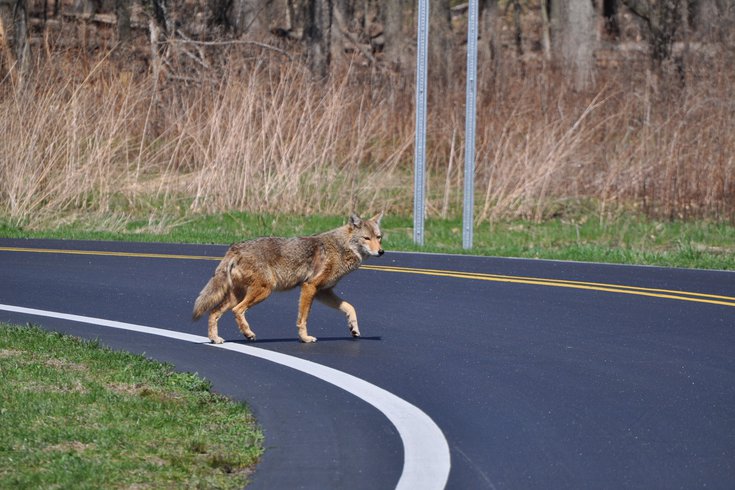
February 02, 2022
 Thomas Shockey/Pexels.com
Thomas Shockey/Pexels.com
The stock photo above shows a coyote crossing a suburban road. Langhorne residents have reported seeing at least one coyote in the Bucks County community in recent weeks. One woman suspects her pet dog may have been killed by the wild animal.
Coyote sightings in the Philadelphia region have become increasingly common in the last several years, with numerous reports stemming from the city, suburbs and South Jersey.
The latest sighting comes from Langhorne, Bucks County, where residents have spotted at least one apparent coyote in recent weeks in the borough's East Ridge development. The animal is suspected to be responsible for the death of one family's small pet dog.
"When I talked to him the next day, he said it was definitely predation. She was definitely somebody's food," recalled Sydney Lewis after her dog was killed in her backyard. https://t.co/B0NJ21DAN1
— Action News on 6abc (@6abc) February 2, 2022
Langhorne resident Sydney Lewis told 6ABC that she found her dog, Laila, lifeless in her backyard after the Maltipoo had been let out to play. When Lewis and her daughter took Laila to see the vet, it was too late.
"He said it was definitely predation," Lewis said. "She was definitely somebody's food."
In January, another Langhorne resident shared photos on Facebook of an apparent coyote in his backyard.
2 coyotes taunting me.. behind the house in langhorne
Posted by Lee Stocker on Friday, January 21, 2022
The Pennsylvania Game Commission confirmed Thursday that it received a report from someone who had a video of a coyote in Langhorne. When the warden contacted this person, the individual also reported Lewis' pet possibly being killed by the coyote in early January.
"We have no confirmed information that the pet was killed by the coyote," said Game Commission spokesperson Dustin Stoner. "We didn't receive a report from the pet owner about it."
The Game Commission did a general patrol through the community where the coyote was spotted, but wardens didn't observe anything. The potential threat to local pets is taken seriously, but no traps have been set because the harm to the animal was a secondary report.
"Coyotes do live in that area and have been there for a long time. They're occasionally seen in the daytime, or dusk and dawn," Stoner said. "People who see them when they're walking their pets get concerned, rightfully so. But we have coyotes in every county in Pennsylvania. It wasn't alarming to get the report of this sighting. Even if we catch a coyote, it would be hard to say whether it's the one that preyed upon a domestic animal."
In recent years, coyotes have been spotted in Philadelphia's Roxborough neighborhood and in suburban Cheltenham and Lower Merion townships.
In South Jersey, a man was attacked by a coyote in broad daylight while walking his dog along the popular Columbia Trail in Washington Township, Gloucester County.
A series of coyote attacks also occurred on Rutgers University's Livingston campus a few years ago.
And in the city of Philadelphia, there was a string of coyote incidents in 2018. One was captured in the Mayfair section of Northeast Philadelphia and another was caught just days later at a dumpster in South Philadelphia. Another one was spotted a few months later near the campus of Chestnut Hill College.
"We've had those instances where a coyote has just kind of become accustomed to city life and comes out in the daytime to search for food, whether it be garbage or pet food left out, or a host of small animals that might live in the city," Stoner said. "They're visible, people see them, and then there's social media and whatnot. Those things get shared pretty quickly and they become a story, where they hadn't in the past."
After past sightings in Roxborough, the Schuylkill Center for Environmental Education explained in a blog post that the presence of these animals marks an evolutionary shift:
Coyotes were not native to Pennsylvania — these are not wild animals reinhabiting their former home. Rather, their cousins and closest competitors the wolves were literally the top dog in our state, but were extirpated in the 19th century, not just from Pennsylvania, but from the entire Northeast.
Meanwhile, coyotes, a western species more likely found in prairie and desert, have survived 200 years of persecution — outright attempts to exterminate them that continue even today. But the clever beast (way more clever than Wile E. of cartoon fame) somehow outwitted us, and as the wolf disappeared, the coyote extended (its) range, moving into the Keystone State as early as the 30s or 40s. The PA Game Commission notes "the coyote continued to expand its range during the late 1970s, and occupied the entire state by 1990, with the highest populations across the northern half of the state."
Over the last decade, coyotes have found advantages to inhabiting more populous areas.
"What's different now is that coyotes are acclimating themselves to suburbs and big cities, where they can den under abandoned properties and hunt mammals like raccoons, opossum, rats and mice, while supplementing their diets with fruits," Schuylkill Center for Environmental Education executive director Mike Weilbacher wrote.
Stoner explained that reports of sightings are increasing because of advances in technology.
"There probably has been more reporting because there has been more surveillance," Stoner said. "People have more home surveillance, so they get sightings on their Ring cams and other camera systems. We see the same thing with bears in the summertime. Historically, these would be anecdotal sightings. Now that we have cameras with infrared, we do get more reports of sightings."
For concerned pet owners, the Game Commission recommends taking a few precautions.
"Make sure that you feed them inside. Don't put pet food outside where it could be accessible to wildlife," Stoner said. "If you have pets, keep them under your control when you take them off your property. Obviously, you should have control of them while you're on your property."
Residents also are advised to properly seal trash cans to avoid attracting wildlife.
Pet owners are generally encouraged to keep cats indoors, and dogs under control during the day and in secured kennels or indoors at night, especially if there have been coyote sightings in the area.
Coyotes are usually shy and elusive. They tend to run the other way when they see people. They should be avoided by people when they are spotted, or if they appear to be unusually habituated to humans. Residents who see a coyote should call 911 to report the location of the sighting.